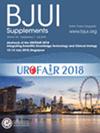External validation of a nomogram for unilateral pelvic lymph node dissection in prostate cancer
IF 3.7
2区 医学
Q1 UROLOGY & NEPHROLOGY
引用次数: 0
Abstract
ObjectivesTo explore the rationale of unilateral extended pelvic lymph node dissection (ePLND) during radical prostatectomy (RP) by external validation of a nomogram for unilateral ePLND (unilat‐NG) and comparison to the Briganti 2019 nomogram.Patients and methodsPatients with magnetic resonance imaging‐fusion biopsy and consecutive RP with bilateral ePLND were identified within an institutional database. The primary endpoint was the detection rate of lymph node invasion (LNI) contralateral to the prostatic lobe with adverse cancer characteristics. The performance of the unilat‐NG and the Briganti 2019 nomogram to detect contralateral LNI was assessed using descriptive analysis, the receiver operating characteristic curve–derived area under the curve (AUC), and multivariable logistic regression analyses.ResultsOf the overall 406 consecutive patients, 68/406 (16.7%) presented with pathological (p)N1 disease at RP. The AUC for the unilat‐NG with a 1%, 2% and 2.5% cut‐off was 0.58 (95% confidence interval [CI] 0.53–0.63), 0.67 (95% CI 0.59–0.75), and 0.69 (95% CI 0.60–0. 77), respectively; compared to an AUC of 0.72 (95% CI 0.66–0.78) for the Briganti 2019 nomogram with a 7% cut‐off. Applying the unilat‐NG with a 2.5% cut‐off, contralateral ePLND could be omitted in 303/406 (74.6%) patients, misclassifying 10/406 (2.5%) patients with pN0 disease.ConclusionThe Briganti 2019 nomogram outperformed the novel unilat‐NG in contralateral LNI prediction. Yet, a significant proportion of patients undergoing unilateral ePLND would be falsely classified with pN0 disease using any of the nomograms. Therefore, bilateral ePLND should remain the standard of care if PLND is indicated.前列腺癌单侧盆腔淋巴结清扫的影像学检查的外部验证
目的通过外部验证单侧扩展盆腔淋巴结清扫(ePLND)的影像学图,并与Briganti 2019影像学图进行比较,探讨根治性前列腺切除术(RP)期间单侧扩展盆腔淋巴结清扫(ePLND)的基本原理。患者和方法在一个机构数据库中确定磁共振成像融合活检和连续RP合并双侧ePLND的患者。主要终点是前列腺叶对侧淋巴结浸润(LNI)的检出率。使用描述性分析、受试者工作特征曲线衍生曲线下面积(AUC)和多变量logistic回归分析来评估unilat‐NG和Briganti 2019 nomogram检测对侧LNI的性能。结果在406例连续患者中,68/406(16.7%)在RP表现为病理(p)N1疾病。在1%、2%和2.5%的截断区间,unilat‐NG的AUC分别为0.58(95%可信区间[CI] 0.53-0.63)、0.67 (95% CI 0.59-0.75)和0.69 (95% CI 0.60-0)。分别为77);而Briganti 2019 nomogram AUC为0.72 (95% CI 0.66-0.78),截断率为7%。在303/406(74.6%)例pN0患者中,使用2.5%切断的unilat - NG可忽略对侧ePLND, 10/406(2.5%)例pN0疾病患者被误诊。结论Briganti 2019 nomogram在对侧LNI预测方面优于新型的unilat‐NG。然而,很大比例的单侧ePLND患者会被错误地归类为pN0疾病。因此,如果需要行双侧ePLND,则仍应采用标准的治疗方法。
本文章由计算机程序翻译,如有差异,请以英文原文为准。
求助全文
约1分钟内获得全文
求助全文
来源期刊

BJU International
医学-泌尿学与肾脏学
CiteScore
9.10
自引率
4.40%
发文量
262
审稿时长
1 months
期刊介绍:
BJUI is one of the most highly respected medical journals in the world, with a truly international range of published papers and appeal. Every issue gives invaluable practical information in the form of original articles, reviews, comments, surgical education articles, and translational science articles in the field of urology. BJUI employs topical sections, and is in full colour, making it easier to browse or search for something specific.
 求助内容:
求助内容: 应助结果提醒方式:
应助结果提醒方式:


